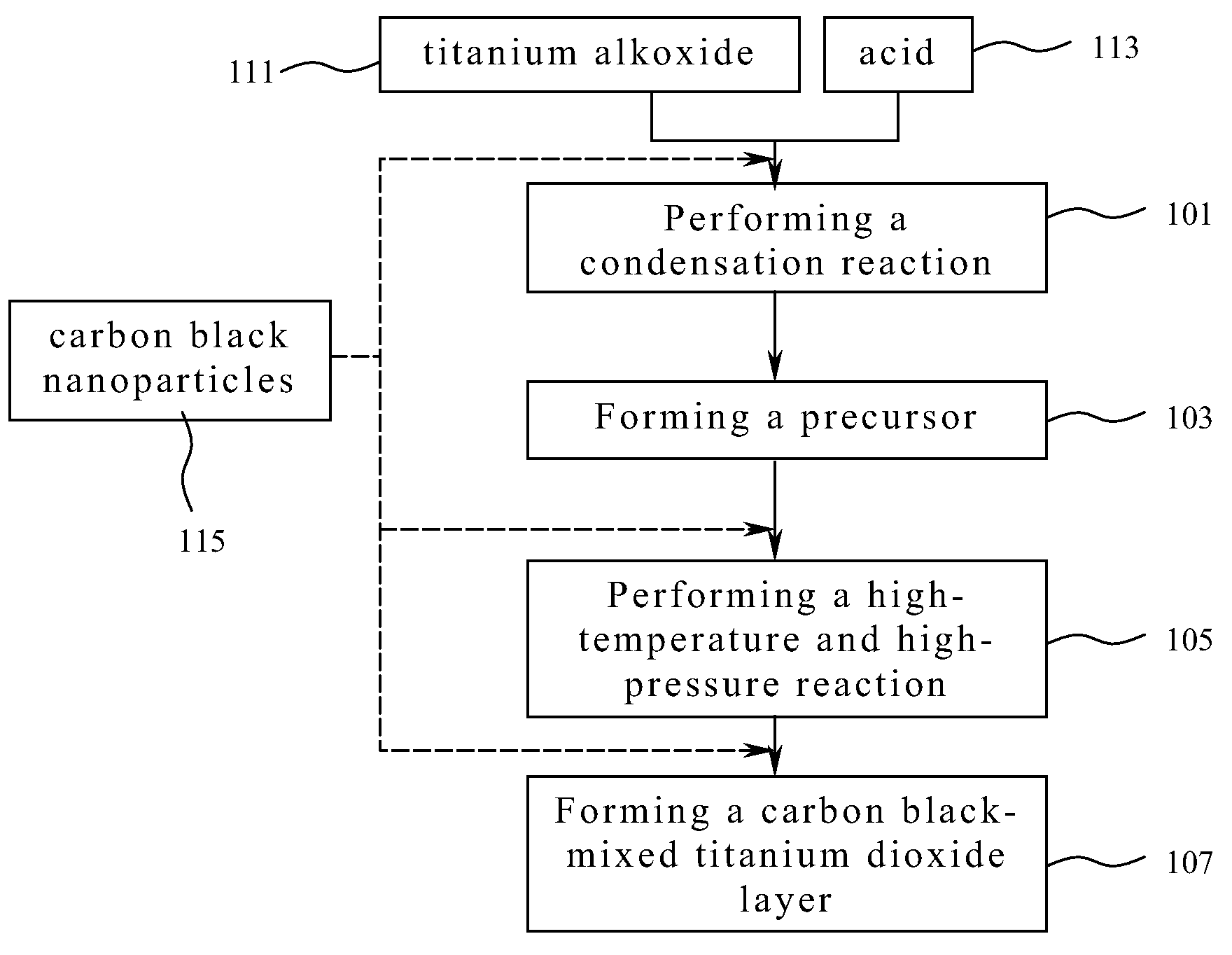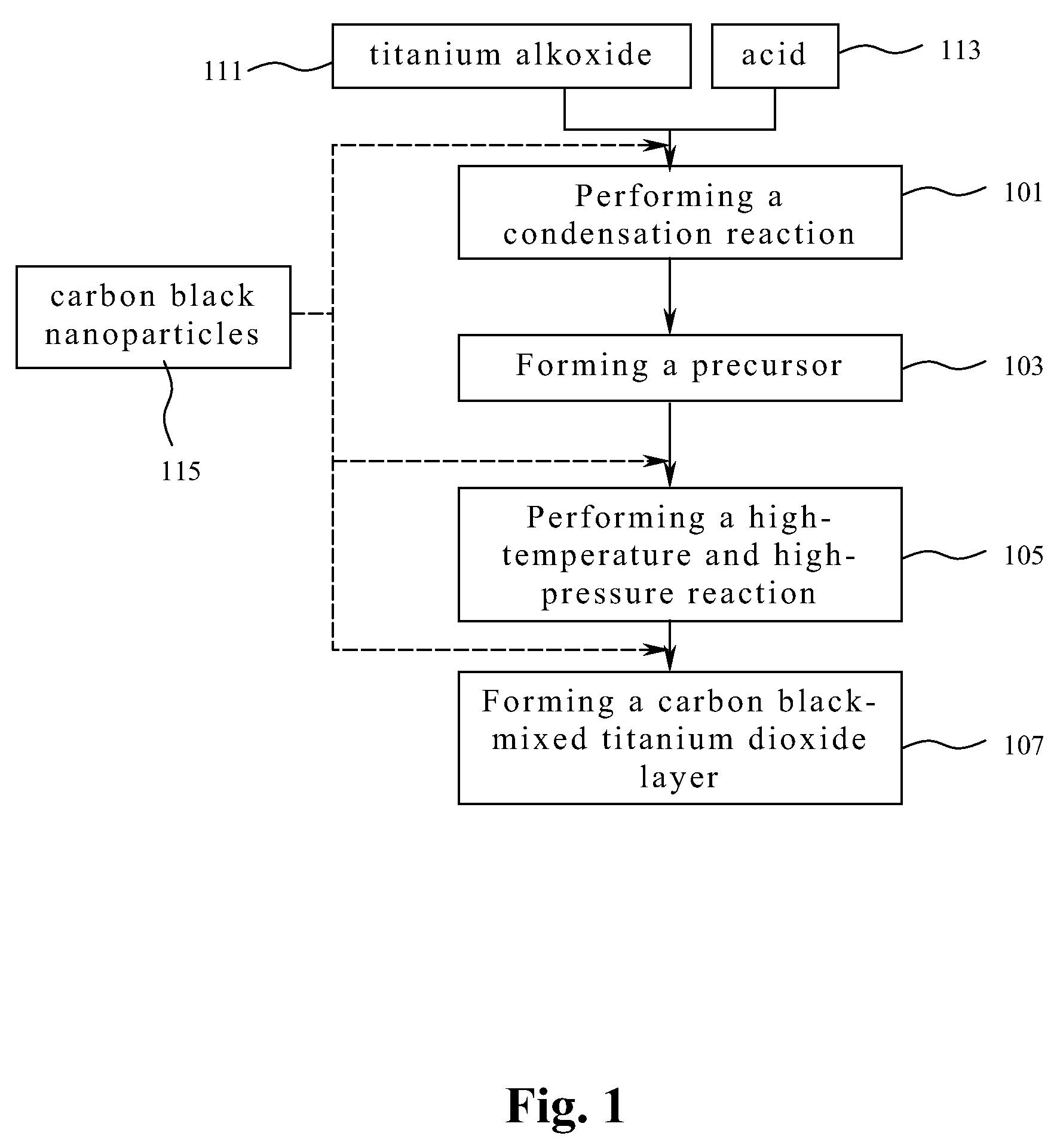Dye-sensitized solar cell, anode thereof, and method of manufacturing the same
a solar cell and dye sensing technology, applied in the field of solar cells, can solve the problems of high cost, lack of natural energy resources, and more than 90% of required energy, and achieve the effect of improving the conversion efficiency of solar energy to electricity for the dssc and increasing the conductivity of the anod
- Summary
- Abstract
- Description
- Claims
- Application Information
AI Technical Summary
Benefits of technology
Problems solved by technology
Method used
Image
Examples
example 1
Preparation of Titanium Dioxide Sol-Gel
[0045]EXAMPLE 1 is related to prepare titanium dioxide sol-gel. Firstly, 12.5 mL of titanium isopropoxide is slowly added into 0.1 M nitric acid solution, 5.0 M hydrochloric acid solution or 8.0 M acetic acid solution until the white precipitation is fully salted-out. At this time, it keeps continuously stirring the solution until the white precipitation is fully resolved and the solution is clear. Next, the nitric acid solution, hydrochloric acid solution or acetic acid solution of the titanium isopropoxide is put into an autoclave (effective volume: about 150 mL, Tsao-Yi Co., Taiwan), continuously stirred under about 80° C. for about 8 hours until the solution becomes white turbid precursor, the precursor is heated to about 200° C. and kept stirring for 2 to 10 hours. Alternatively, the nitric acid solution, hydrochloric acid solution or acetic acid solution of the titanium isopropoxide is put into an autoclave and heated to about 200° C. and...
example 2
Preparation of Carbon Black-Mixed Titanium Dioxide Sol-Gel
[0048]EXAMPLE 2 is related to prepare a carbon black-mixed titanium dioxide sol-gel obtained by methods A, B or C, which is added with carbon black nanoparticles during various stages.
[0049]Method A: Firstly, 12.5 mL of titanium isopropoxide is slowly added into 8.0 M acetic acid solution until the white precipitation is fully salted-out. At this time, it keeps continuously stirring the solution until the white precipitation is fully resolved and the solution is clear. Next, the carbon black nanoparticles are added into the acetic acid solution of the titanium isopropoxide and continuously stirred for a half hour. Later, the acetic acid solution of the titanium isopropoxide mixed with the carbon black nanoparticles is put into the autoclave the same with EXAMPLE 1, continuously stirred under about 80° C. for about 8 hours until the solution becomes white turbid precursor mixed with the carbon black nanoparticles, the precurso...
example 3
Preparation of Carbon Black-Mixed Titanium Dioxide Membrane Electrode
[0052]EXAMPLE 3 is related to prepare a carbon black-mixed titanium dioxide membrane electrode. At first, in this example, the carbon black-mixed titanium dioxide sol-gel is dispersed in 95 wt. % ethanol solution for obtaining a slurry with a solid content of 15 wt. %.
[0053]Next, the slurry is blade-coated on a transparent glass or plastic substrate having indium tin oxide (ITO) (the plastic substrate may be made of poly(ethylene terephthalate) (PET), for example), and then the coated transparent substrate is placed and dried for about 30 minutes. Afterward, the coated transparent substrate is dried on a hot plate under about 50° C. for 10 minutes, so as to obtain the carbon black-mixed titanium dioxide membrane electrode.
[0054]Reference is made to Table 3, which is an analyzing result of BET, crystallized domain size, average particle size and crystallinity of the carbon black-mixed titanium dioxide membrane elect...
PUM
 Login to View More
Login to View More Abstract
Description
Claims
Application Information
 Login to View More
Login to View More - R&D
- Intellectual Property
- Life Sciences
- Materials
- Tech Scout
- Unparalleled Data Quality
- Higher Quality Content
- 60% Fewer Hallucinations
Browse by: Latest US Patents, China's latest patents, Technical Efficacy Thesaurus, Application Domain, Technology Topic, Popular Technical Reports.
© 2025 PatSnap. All rights reserved.Legal|Privacy policy|Modern Slavery Act Transparency Statement|Sitemap|About US| Contact US: help@patsnap.com



